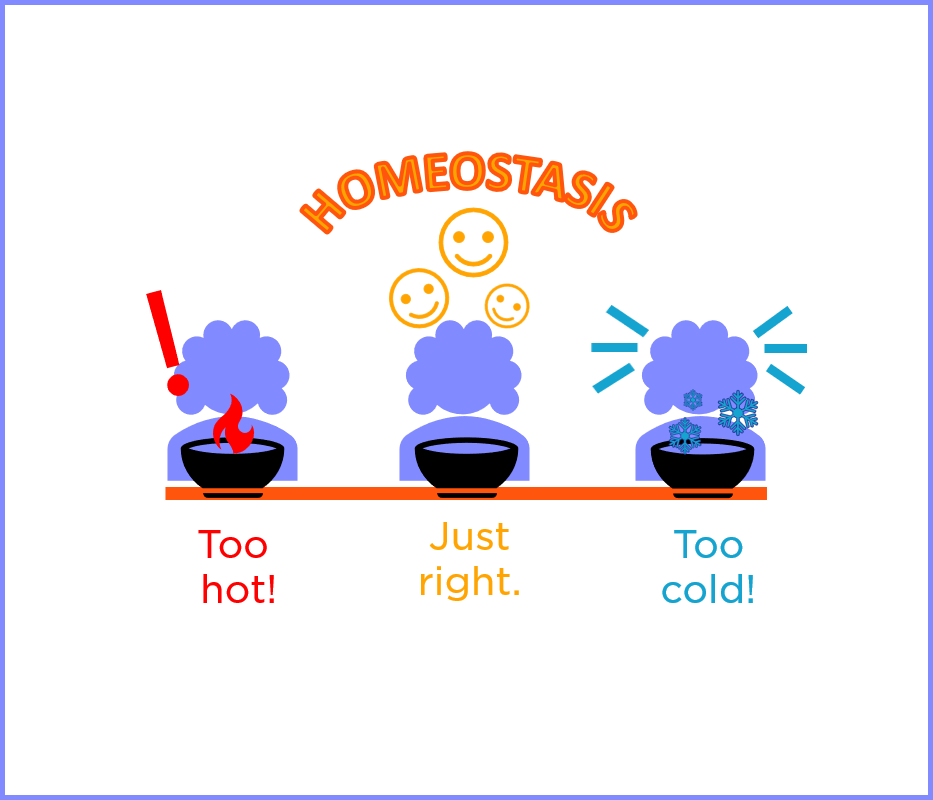Introduction
- Homeostasis is derived from the ancient Greek words ὅμοιος (pronounced: hómoios) and ἵστημι (pronounced: hístēmi), which means “same” and “steady”.
- Dr. Walter Cannon first used the word in 1930. His book the “Wisdom of the Body” explains how the human body maintains constant blood oxygen levels, water, salt, sugar, protein, and fat levels, as well as body temperature.
- The environment of the Earth is dynamically kept in a stable state by similar mechanisms.
Homeostasis is any strategy used by living creatures to actively maintain the relatively consistent conditions required for existence. Feedback loops are employed to maintain the steady state of Homeostasis.
What is Homeostasis?
- Homeostasis is the maintenance of consistent internal chemical and physical state by a living being in response to the changing conditions to survive and function optimally.
- Homeostasis is a self-regulating mechanism that controls the internal factors required for sustaining life.
- In order to maintain a consistent internal environment, it uses feedback controls and other regulatory processes.
- It includes controlling a number of physiological parameters, including glucose levels, pH, and temperature.

Examples of Homeostasis in Human Body
Body Temperature
By controlling the flow of heat into and out of the body, the body keeps its internal temperature at around 98.6°F (37°C).
- The body reacts to an increase in body temperature by increased perspiration to cool down, such as during exercise or a fever.
- On the other hand, when the body temperature decreases, the body reacts by shivering in an effort to produce heat.
Blood Glucose Levels
In order to maintain a consistent supply of energy for the cells, the body closely controls blood glucose levels.
- The pancreas releases insulin to facilitate the absorption of glucose by cells when blood sugar levels rise, such as after a meal.
- When blood sugar levels fall, the pancreas secretes glucagon, which prompts the liver to release glucose that has been stored there.
pH Balance
The blood and tissues in the body are kept at a slightly alkaline pH to guarantee its optimal functioning.
- The body responds by speeding up breathing to get rid of extra carbon dioxide, which can lead to acidosis, when the pH levels become excessively acidic.
- On the other hand, when the pH levels rise too high, the body reacts by slowing down breathing to hold onto carbon dioxide, which can result in alkalosis.
Blood Pressure
The body controls blood pressure to ensure that tissues and organs receive the right amount of blood.
- The body reacts to high blood pressure by speeding up the heartbeat and tightening blood vessels to maintain blood flow, such as during physical exertion or times of stress.
- The body reacts to a reduction in blood pressure, such as occurs during sleep or relaxation, by slowing the heart rate and dilation of blood vessels to enhance blood flow.
Fluid and Electrolyte Balance
- To maintain perfect hydration and electrolyte concentrations in the blood and tissues, the body controls the balance of fluids and electrolytes.
- The body reacts to fluid loss by raising thirst and secreting hormones that encourage the retention of water and electrolytes, such as when sweating or urinating.
Regulation of Homeostasis
Numerous physiological processes cooperate to monitor and control physiological variables as part of the maintenance of homeostasis. Here are a few ways the body controls homeostasis:
- Feedback Mechanisms: Homeostasis control relies heavily on feedback mechanisms. To deal with changes in physiological variables, the body uses negative feedback loops. For instance, as body temperature rises, the body reacts by creating sweating to cool down, which lowers body temperature.
- Hormonal Regulation: Hormones are chemical messengers that the body secretes through glands to control a range of physiological functions. The control of hormones is necessary for maintaining homeostasis. Insulin and glucagon, for example, control blood sugar levels.
- Nervous System Regulation: The control of homeostasis involves the neurological system as well. The autonomic nervous system regulates a number of the body’s involuntary processes, including heart rate, blood pressure, and breathing frequency.
- Kidney Function: The kidneys play an important part in homeostasis regulation by eliminating waste from the body and maintaining electrolyte balance. The kidneys also manage fluid balance by regulating urine production.
- Immune System Regulation: The immune system aids in the regulation of homeostasis by protecting the body against infections and illnesses. The immune system also regulates inflammation, which is a vital factor in healing and tissue repair.
- Behavioral Regulation: Homeostasis regulation is also influenced by behavioral variables like as food, exercise, and sleep. These activities can have an effect on physiological factors such as blood glucose levels, body temperature, and fluid balance.
These mechanisms work together to maintain a stable internal environment within the body despite external changes.

What is the feedback mechanism?
A feedback mechanism is a physiological process that regulates the amount of an element in the body by monitoring and reacting to changes in that parameter. Negative feedback and positive feedback are the two types of feedback processes.
Homeostasis and positive feedback mechanisms
- Positive feedback, which attempts to increase or promote an adjustment in a variable, is a less common feedback mechanism.
- When the body detects a change in a variable, it responds by enhancing the change.
- This can be advantageous in some situations, such as labor, when the release of oxytocin enhances uterine contractions, resulting in the delivery of the baby.
Example of Positive feedback mechanism in Homeostasis
1. Childbirth:
The labor and delivery process is a positive feedback system.
- When a woman is in labor, the baby’s head presses against the cervix, causing the brain to produce the hormone oxytocin.
- Oxytocin induces the uterine muscles to contract, pushing the baby’s head against the cervix even more, resulting in even more oxytocin release.
- This cycle is repeated until the baby is born.
2. Action potential generation
When one neuron gets a signal from another, it produces an action potential, which is a short electrical impulse that travels along the length of the neuron.
The formation of an action potential is a positive feedback process in which the opening of voltage-gated sodium channels generates an inflow of sodium ions, which depolarizes the neuron and induces additional sodium channels to open.
3. Blood clotting
Blood clotting is a positive feedback mechanism in which a primary aggregation of platelets at the site of a wound causes a discharge of compounds that activate additional platelets, resulting in the creation of a blood clot.
4. Lactation
The milk release process while nursing is a positive feedback mechanism.
- When a baby starts nursing, the suckling movement transmits a message to the brain’s activity, causing the hormone prolactin to be released, leading to the secretion of milk.
- As the infant keeps on eating, the pressure of the breastmilk induces the oxytocin hormone to be released, causing the milk to be expelled from the breast and stimulating additional milk production.
5. Sneezing
- Sneezing is a positive feedback mechanism in which the the inflammation or irritation of nose trigger the sneeze.
- The response involves a deep inhale, followed by a powerful exhale via the nose and mouth, expelling the irritant and clearing the nasal passages.
Homeostasis and negative feedback mechanisms
- Negative feedback is the most popular sort of feedback mechanism, and it helps sustain homeostasis. In negative feedback, one’s body detects a shift in a variable such as body temperature, blood glucose levels, or blood pressure.
- If the variable is beyond of its usual range, the body adjusts by launching a series of physiological reactions to counteract the change and restore the variable to its normal range.
- For example, when body temperature increases over the usual range, the body begins sweating to lower body temperature and return it to the normal range.
Examples of Negative feedback mechanism in homeostasis
1. Body temperature regulation
Body temperature has a fixed point, and negative feedback systems attempt to preserve the set temperature by beginning actions that either increase or reduce body temperature.
When the body’s temperature rises, for example, as a result of exercise or being in a hot environment, negative feedback mechanisms cause sweating, which decreases the body through the process of evaporative cooling.
When the body temperature falls, negative feedback processes cause shivering, which causes muscular contractions to create heat.
2. Blood glucose regulation
Through negative feedback mechanisms, our body keeps its blood sugar levels under strict control.
- Blood glucose levels increase after eating food, which causes the pancreas to produce insulin. Blood sugar levels are brought back to the target range thanks to insulin, which encourages the absorption and storage of glucose by cells.
- On the other hand, glucagon, a hormone released by the pancreas in response to dangerously low blood sugar levels, prompts the liver to release glucose into the bloodstream.
3. Blood pressure regulation
In order to keep blood pressure within a specific range, the body uses negative feedback mechanisms to control blood pressure.
- Blood pressure is lowered when vasodilation, which widens blood vessels, and a slower heart rate are triggered as a result of negative feedback processes when blood pressure rises.
- On the other hand, when blood pressure falls, negative feedback mechanisms start to function, causing reactions like vasoconstriction (blood vessel narrowing) and elevated heart rate, which increase blood pressure.
4. Calcium homeostasis:
The hormones parathyroid hormone (PTH) and calcitonin work together to provide negative feedback mechanisms in our bodies that control the amount of calcium in the blood.
- In response to a fall in blood calcium levels, the parathyroid gland produces PTH, which promotes the release of calcium from bone and heightens calcium reabsorption in the kidneys. Blood calcium levels rise as a result, returning to the target range.
- As opposed to this, when blood calcium levels rise, the thyroid gland produces calcitonin, which encourages the absorption of calcium by bones and lessens calcium reabsorption in the kidneys.
5. pH regulation:
Through negative feedback processes, the body keeps blood pH within a certain range.
- The pancreas and kidneys produce bicarbonate ions as a buffer to neutralize extra acid and bring blood pH back up to the set point when blood pH falls as a result of negative feedback processes.
- If blood pH increases, on the other hand, negative feedback mechanisms trigger the kidneys’ release of hydrogen ions, which operate to bring blood pH back down to the set point.
Importance of Homeostasis and Feedback loop
1. Maintenance of stability: By keeping the body stable, homeostasis enables healthy cell, tissue, and organ function. It makes sure that the environment inside the body doesn’t change, which is crucial for healthy physical processes.
2. Controls physiological processes: Homeostasis controls physiological processes like pH levels, blood pressure, blood sugar levels, and body temperature. For a person to remain in peak health and function, these processes are essential.
3. Adaptation: Homeostasis enables the body to adjust to environmental changes. For instance, when exercising or when it’s hot outside, sweating helps control body temperature.
4. Disease prevention: Disease can result from a disturbance in equilibrium. For instance, illnesses like diabetes or heart disease might result from excessive blood pressure or blood sugar levels. Keeping homeostasis aids in avoiding such situations.
5. Improvement of survival: Homeostasis is crucial to the continued existence of all living things. Cells wouldn’t be able to operate correctly without homeostasis, and the body wouldn’t be able to react to environmental changes.